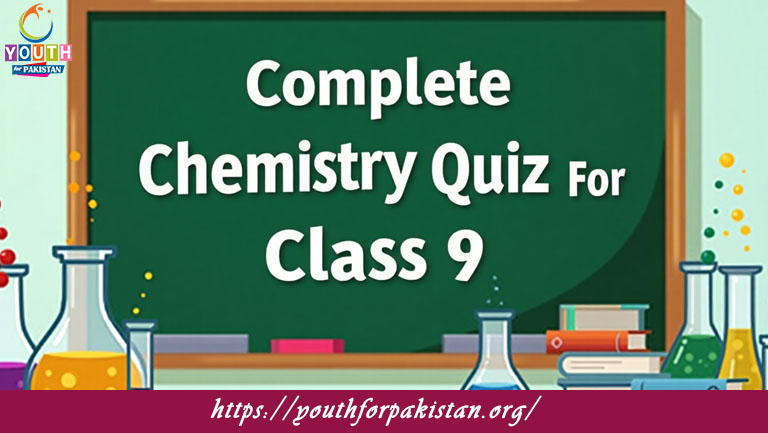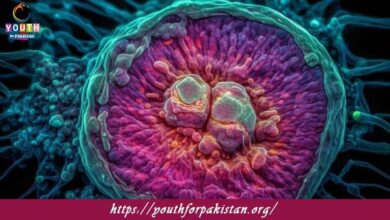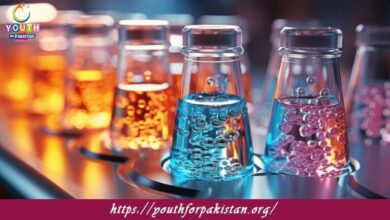Chemistry is very important in understanding the MDCAT syllabus because most of the medical concepts, especially in biochemistry and pharmaceutical sciences, are based on chemistry. The 9th Class Chemistry Complete Quiz serves as a crucial tool for students to strengthen their basic knowledge in key subjects, including atomic structure, periodic tables, chemical bondings, acids, bases, and salts. It helps students self-evaluate and prepare for complex problems they might encounter both in academic and entrance exams.
Key Topics Covered in the Chemistry Quiz
The 9th Class Chemistry Complete Quiz covers a variety of topics for the best possible preparation. Questions on matter and its properties, atomic theory, molecular formulae, and chemical reactions will be found by the students. Chapters on solutions, mixtures, and electrochemistry are also included so that students can understand the theoretical and practical aspects of chemistry.
This quiz is designed to improve critical thinking and problem-solving abilities. It helps students apply knowledge to real-life situations, ensuring they can answer tricky questions that may appear in the MDCAT Chemistry section.
Quiz for Practice
The MDCAT Quiz for 9th Class Chemistry provides exam-oriented questions for students to prepare effectively. It focuses on frequently tested concepts and contains a variety of multiple-choice questions (MCQs) so that students get familiar with the type of questions they will face in exams. Regular practice of these quizzes improves time management, accuracy, and analytical thinking, which are very vital for entrance exams.
- Test Name: 9th Class Chemistry Complete Quiz
- Total Questions: 240
- Total Marks: 240
- Time: 120 minutes
Note: Answer of the questions will change randomly each time you start the test, once you are finished, click the View Results button.
0Get Your Username and Password for MDCAT Tests
Sign Up Now
Free Flashcard for Quick Revision
In addition to quizzes, students can use free flashcards to revise key chemical formulas, equations, and definitions from the 9th Class Chemistry syllabus. These flashcards provide quick and efficient revision of crucial information that can be recalled during exams. Flashcards are an excellent tool for last-minute preparation, making complex topics easy to remember.

What is the term for a reaction in which electrons are transferred between reactants?

Which type of reaction involves the exchange of ions between two compounds?

What is the term for the gain of electrons by a substance during a chemical reaction?

Which type of reaction involves the reaction between an acid and a base to produce water and a salt?

What is the term for a chemical reaction that involves the exchange of ions between two compounds?

What is the term for a substance that speeds up a chemical reaction by providing an alternative pathway with lower activation energy?

What type of reaction occurs when a metal reacts with an acid to produce hydrogen gas and a salt?

What is the term for the reactant that is completely consumed in a chemical reaction?

What is the term for the reactant in excess in a chemical reaction?

What is the term for a substance that speeds up a chemical reaction without being consumed in the process?

What is the term for a chemical reaction that absorbs energy from its surroundings?

What is the term for a chemical reaction that releases energy in the form of heat or light?

Which factor does not affect the rate of a chemical reaction?

What is the term for a substance that undergoes a chemical reaction?

What is the term for a substance formed by a chemical reaction?

What is the term for a substance that speeds up a chemical reaction by lowering the activation energy?

What type of reaction occurs when a metal reacts with an acid to produce hydrogen gas and a salt?

Which type of reaction involves the transfer of electrons between reactants?

What is the term for the number of particles in one mole of a substance?

What is the term for the rearrangement of atoms or ions to form new substances?

What is the term for the process of breaking down a molecule into smaller molecules or atoms?

What is the term for a substance that slows down the rate of a chemical reaction?

What is the term for a substance that speeds up the rate of a chemical reaction without being consumed?

Which factor does not affect the rate of a chemical reaction?

What is the term for the minimum amount of energy required to start a chemical reaction?

What type of reaction occurs when a metal oxide reacts with an acid to produce a salt and water?

What type of reaction occurs when an acid reacts with a metal to produce hydrogen gas and a salt?

What type of reaction occurs when a non-metal displaces another non-metal in a compound?

What type of reaction occurs when a metal displaces another metal in a compound?

What is the process called when an atom or ion loses electrons?

What is the term for the electrode where reduction occurs in an electrochemical cell?

What is the process of using electricity to convert chemical energy into electrical energy?

What is the term for the ratio of the actual voltage of a cell to its standard cell potential?

Which of the following metals is commonly used as a reference electrode in electrochemistry?

What is the term for the reduction potential of an electrode measured against a standard hydrogen electrode?
Standard reduction potential

Which of the following is not a type of electrochemical cell?

What is the formula for calculating charge using Faraday's constant?

What is the process of using electricity to coat a metal object with a thin layer of metal called?

What is the term for the measure of the ability of a substance to conduct electricity?

What is the term for the force that drives the flow of electrons in a circuit?

What is the unit of electric charge equal to one coulomb per second?

What is the process of breaking down a compound using electricity called?

Which of the following is not a component of an electrochemical cell?

What is the term for the maximum potential difference between the cathode and anode in an electrochemical cell?

What is the electromotive force (EMF) of a cell under standard conditions called?

What is the formula for calculating cell potential under standard conditions?
E°cell = E°cathode - E°anode

What is the term for the electrode potential of a half-cell measured against a standard hydrogen electrode?
Standard electrode potential

What is the process of preventing corrosion of a metal by applying a protective layer of another metal?

What is the process of using an external source of electric current to force a non-spontaneous chemical reaction?

Which of the following is a measure of a material's opposition to the flow of electric current?

What is the SI unit of electrical resistance?

What is the term for the flow of electric charge per unit time?

What is the Faraday constant approximately equal to?

What is the quantity of electric charge transferred by one mole of electrons?

What is the process of depositing a thin layer of metal onto a surface using electricity?

What is the term for the movement of ions in solution under the influence of an electric field?

What is the unit of electric current?

Which law states that the current flowing through a conductor is directly proportional to the voltage across it?

What is the standard hydrogen electrode used as a reference in electrochemistry?

What is the symbol for standard electrode potential?

Which factor does not affect the solubility of a solid solute in a liquid solvent?

What is the term for a solution that has a low concentration of solute compared to solvent?

What is the term for a solution that has a high concentration of solute compared to solvent?

What is the term for a solution that contains an equal amount of solute and solvent?

What is the term for a solution that contains the maximum amount of solute that can dissolve at a given temperature?

What is the term for the mass of solute in a given volume of solution, usually expressed in grams per liter (g/L)?

What is the term for a solution that contains less solvent than solute at a given temperature?

What is the term for a solution that contains more solvent than solute at a given temperature?

What is the term for the ratio of the amount of solute to the amount of solution, expressed as a percentage?

What is the term for a solution that contains less solute than solvent can normally dissolve at a given temperature?

What is the process called when a solid directly changes to a gas without passing through the liquid state?

Which of the following is not a factor that affects the rate of dissolution of a solid in a liquid?

What is the term for the separation of a solid from a solution?

What is the term for a solution that contains more solute than solvent can normally dissolve at a given temperature?

What is the process called when a gas escapes from a liquid in a solution and forms bubbles?

Which of the following factors does not affect the solubility of a solid in a liquid?

What happens to the solubility of most gases in water as temperature increases?

What happens to the solubility of most solids in water as temperature increases?

What is the solubility of a gas in a liquid typically affected by?

What type of solution is formed when no more solute can dissolve in a solvent at a given temperature?

What is the term for a solution that contains equal amounts of solute and solvent at a given temperature?

What is the term for a solution that contains less solute than it could dissolve at a given temperature?

What is the solubility of a substance that only partially dissolves in a solvent at a given temperature?

What is the solubility of a substance that dissolves completely in a solvent at a given temperature?

What type of solution contains more solute than would normally dissolve at that temperature?

What is the process called when excess solute is added to a saturated solution, but it does not dissolve?

What is the term for a solution that can dissolve more solute at a given temperature?

What is the term for a solution that has reached its maximum concentration of solute at a given temperature?

Which of the following solutions has the lowest concentration?

Which of the following solutions has the highest concentration?

At which temperature does sulfur boil at normal atmospheric pressure?

What is the physical state of iodine at room temperature and normal atmospheric pressure?

At which temperature does water boil at a high altitude where atmospheric pressure is lower?

What is the physical state of oxygen at a temperature of -218°C?

What is the physical state of nitrogen at a temperature of -210°C?

At which temperature does mercury freeze at normal atmospheric pressure?

What is the physical state of carbon dioxide at a temperature of -78.5°C?

What is the physical state of water at a temperature of -10°C?

At which temperature does nitrogen freeze at normal atmospheric pressure?

What is the physical state of oxygen at a temperature of -183°C?

What is the physical state of helium at a temperature of -269°C?

At which temperature does carbon dioxide freeze at normal atmospheric pressure?

What is the physical state of sulfur dioxide (SO2) at room temperature and normal atmospheric pressure?

What is the physical state of argon at room temperature and normal atmospheric pressure?

At which temperature does nitrogen boil at normal atmospheric pressure?

What is the physical state of ammonia (NH3) at room temperature and normal atmospheric pressure?

What is the physical state of hydrogen at a temperature of -253°C?

What is the physical state of sulfur at room temperature and normal atmospheric pressure?

What is the physical state of carbon at room temperature and normal atmospheric pressure?

At which temperature does ethanol (C2H5OH) boil at normal atmospheric pressure?

What is the physical state of water at a temperature of 50°C?

What is the physical state of nitrogen at a temperature of -196°C?

What is the physical state of helium at a temperature of -269°C?

What is the physical state of bromine at room temperature and normal atmospheric pressure?

At which temperature does oxygen freeze at normal atmospheric pressure?

What is the physical state of ethanol (C2H5OH) at room temperature and normal atmospheric pressure?

What is the physical state of iodine at room temperature and normal atmospheric pressure?

Which physical state of matter has a definite volume but takes the shape of its container?

What is the physical state of neon at room temperature and normal atmospheric pressure?

What is the physical state of gold at room temperature and normal atmospheric pressure?

How many lone pairs of electrons are there in a molecule of methane (CH4)?

How many lone pairs of electrons are there in a molecule of water?

What is the shape of a nitrogen molecule (N2)?

What is the molecular geometry of carbon dioxide?

How many lone pairs of electrons are there in a molecule of carbon monoxide?

What is the shape of a carbon monoxide molecule?

What is the molecular geometry of water?

How many lone pairs of electrons are there in a molecule of carbon tetrachloride?

What is the shape of a carbon tetrachloride molecule?

What is the molecular geometry of ammonia?

How many lone pairs of electrons are there in a molecule of methane?

What is the shape of a methane molecule?

What is the molecular geometry of carbon dioxide?

How many lone pairs of electrons are there in a molecule of water?

What is the shape of a nitrogen molecule (N2)?

What is the molecular geometry of carbon dioxide?

How many lone pairs of electrons are there in a molecule of carbon monoxide?

What is the shape of a carbon monoxide molecule?

What is the molecular geometry of water?

How many lone pairs of electrons are there in a molecule of carbon tetrachloride?

What is the shape of a carbon tetrachloride molecule?

What is the molecular geometry of ammonia?

How many lone pairs of electrons are there in a molecule of methane?

What is the shape of a methane molecule?

What is the molecular geometry of carbon dioxide?

How many lone pairs of electrons are there in a molecule of water?

What is the shape of a nitrogen molecule (N2)?

What is the molecular geometry of carbon dioxide?

How many lone pairs of electrons are there in a molecule of carbon monoxide?

What is the shape of a carbon monoxide molecule?

What is the trend in boiling point down a group in the periodic table?

What is the trend in melting point across a period in the periodic table?

What is the chemical symbol for neon?

What is the period number of an element with atomic number 30?

Which group of elements is known as the noble gases?

Which of the following elements is a nonmetal?

What is the chemical symbol for hydrogen?

Which element is located in Group 18 of the periodic table?

What is the trend in reactivity of halogens down a group in the periodic table?

What is the trend in reactivity of alkali metals down a group in the periodic table?

What is the trend in metallic character down a group in the periodic table?

What is the trend in metallic character across a period in the periodic table?

What is the chemical symbol for calcium?

Which group of elements is known as the halogens?

What is the period number of an element with atomic number 20?

Which of the following elements is a transition metal?

What is the chemical symbol for chlorine?

Which element is located in Period 4 and Group 14 of the periodic table?

Which of the following elements is a metal?

What is the chemical symbol for sodium?

Which group of elements is known as the alkaline earth metals?

What is the trend in ionization energy down a group in the periodic table?

What is the trend in ionization energy across a period in the periodic table?

What is the trend in electronegativity down a group in the periodic table?

What is the trend in electronegativity across a period in the periodic table?

What is the trend in atomic radius down a group in the periodic table?

What is the trend in atomic radius across a period in the periodic table?

What is the chemical symbol for mercury?

Which of the following elements is a metalloid?

What is the period number of an element with atomic number 13?

What is the maximum number of electrons in the p subshell?

Who proposed the quantum mechanical model of the atom?

What is the electron configuration of sodium?

What is the electron configuration of oxygen?

What is the electron configuration of carbon?

What is the principal quantum number range for an electron in the s subshell?

What is the principal quantum number range for an electron in the p subshell?

What is the principal quantum number range for an electron in the d subshell?

What is the magnetic quantum number range for an orbital in the s subshell?

What is the magnetic quantum number range for an orbital in the p subshell?

What is the magnetic quantum number range for an orbital in the d subshell?

What is the shape of an f orbital?

What is the shape of a d orbital?

What is the shape of a p orbital?

What is the maximum number of electrons in the third shell?

What is the maximum number of electrons in the second shell?

What is the maximum number of electrons in the first shell?

What is the maximum number of electrons in an orbital?

Which quantum number determines the shape of an orbital?

Who proposed the wave mechanical model of the atom?

What is the shape of an s orbital?

Which of the following is not true about electrons?
They are negatively charged

Distance from the nucleus to the electron in the first shell

Which of the following determines the mass of an atom?

Which scientist discovered the neutron?

Which subatomic particle has a negligible mass?

What is the mass number of an element?
Sum of protons and neutrons

What is the atomic number of an element?

Which of the following is not found in the nucleus?

Which subatomic particle is found in the nucleus?

Which of the following is a transition metal?

What is the atomic number of helium?

Which of the following is a halogen?

What is the chemical symbol for calcium?

What is the chemical formula for hydrochloric acid?

Which of the following is a noble gas?

What is the atomic number of nitrogen?

Which of the following is a metal?

What is the charge of a neutron?

Which of the following is an alkaline earth metal?

What is the chemical symbol for lead?

What is the chemical formula for carbon dioxide?

What is the pH value of a basic solution?

Which of the following is a transition metal?

What is the atomic number of hydrogen?

Which of the following is a halogen?

What is the chemical symbol for mercury?

What is the chemical formula for sodium chloride?

What is the pH value of an acidic solution?

Which of the following is a metalloid?

What is the charge of an electron?

What is the chemical symbol for potassium?

What is the chemical formula for sulfuric acid?

Which of the following is a noble gas?

What is the atomic number of oxygen?

Which of the following is a nonmetal?

What is the chemical symbol for iron?

What is the chemical formula for ammonia?

Which of the following is an alkali metal?

What is the charge of a proton?
























































